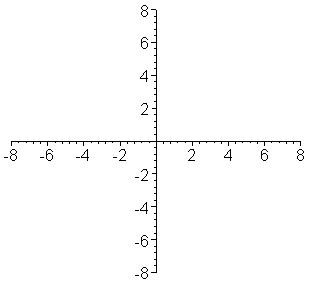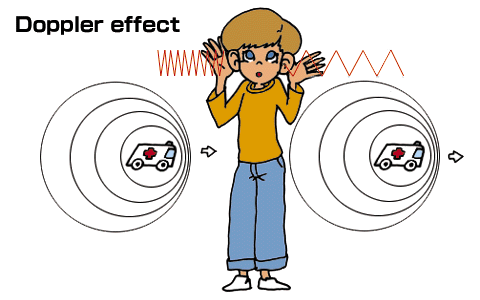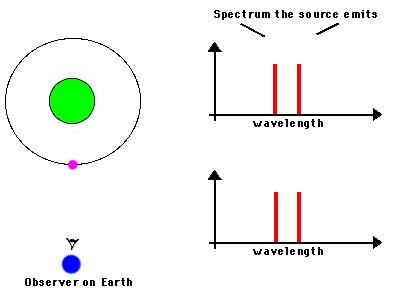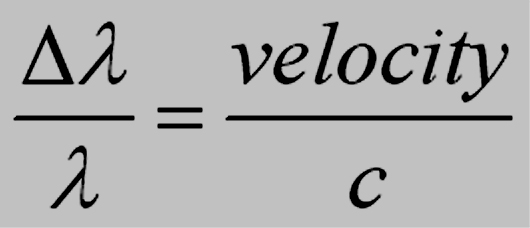 |
A continuous spectrum has at least some
light at all the wavelengths.(From R. J. Lavery, http://www..phy.nau.edu/~lavery/Mypage/Astrostuff/A150WEB1998/main2.html#startnotes)
A blackbody spectrum is a particular type of continuous spectrum. |
Spectroscopy: A Key Part of the Astronomer's Toolbox
Key points: origin of emission and absorption lines; spectra as a cosmic barcode; Doppler effect
Spectrum: the distribution of intensities of light over wavelength
 |
A continuous spectrum has at least some
light at all the wavelengths.(From R. J. Lavery, http://www..phy.nau.edu/~lavery/Mypage/Astrostuff/A150WEB1998/main2.html#startnotes)
A blackbody spectrum is a particular type of continuous spectrum. |
Gases can have more complex emission- and absorption-line spectra, allowing us to learn a lot about their conditions.
Emission- and absorption-line spectra are produced by atoms (and molecules)
 |
Atoms consist of nuclei made of protons and neutrons, and electrons
around them. Hydrogen (1 proton) and helium (2 protons) are the simplest; there are atoms
with up to about 100 protons, giving 100 elements (figure by G. Rieke).
The electrons in an atom are held by the electric force, which is proportional to 1/r2 just like gravity. This force attracts positive and negative electric charges, but repels like charges - two positives or two negatives. The protons in the nucleus of the atom are held together by the "strong force", which is clearly much stronger than the electric one but works only over very small distances. |
 |
If a photon of exactly the right
energy "hits" an atom, it can be absorbed and cause an electron to jump to an
outer, higher energy orbit.(The Amazing World of Electrons
and Photons - Thinkquest http://library.thinkquest.org/16468/gather/english.htm)
A photon of the same energy is emitted when the electron falls back down to its original orbit. |
 |
Electrons can also be raised to outer orbits when atoms collide A photon of the characteristic energy is emitted when the electron falls back to its original orbit. |
 |
In astronomical situations, we may see either emission
lines in a spectrum or absorption lines depending on the relationships of the the
sources and gases involved (animation by G. Rieke) An absorption line spectrum is produced when cool gas lies between a continuum source and us; the specific wavelengths absorbed by the atoms in the gas are removed from the light that comes to us. An emission line spectrum is produced when photons are emitted by gas that is thin enough to be transparent in the continuum. |
Absorption- and emission-line spectra:
 |
(From R. J. Lavery, http://www..phy.nau.edu/~lavery/Mypage/Astrostuff/A150WEB1998/main2.html#startnotes) |
 |
(From R. J. Lavery, http://www..phy.nau.edu/~lavery/Mypage/Astrostuff/A150WEB1998/main2.html#startnotes) |
If even more energy is supplied to an electron, it can
escape from the atom leaving the positively charged nucleus. Because the electron is no
longer transitioning between two specific energy states, the atom can absorb a range of
energies in this situation. Electrons over a range of energies can be captured by the
positive nucleus, emitting photons over a range of energies![]()
Spectroscopy of astronomical sources has been a key to our understanding of the Universe because spectra are:
1) Aids in determining temperatures (can be more reliable than looking at the wavelength peak)
The higher the temperature, the more electrons are in high energy orbits or have escaped altogether from their atoms, causing emission of specific lines associated only with the high energy orbits that are inaccessible at low temperature.
| 2) Probes of
composition. Because each element (and also each type of molecule) has its
own set of permitted orbits for its electrons and hence its own pattern of spectral lines,
spectra can be used to
determine what an object is made of (here
are some examples from A. Larson, http://www.astro.washington.edu/astro101v): |
Argon |
 |
| |
 |
|
 |
||
| |
 |
|
| |
 |

 |
The frequency of a wave is modified by the motion of a
source toward or away from the observer. In the case of electromagnetic radiation: Toward produces "blueshift" ==> spectral lines are shifted towards shorter wavelengths Away produces "redshift" ==> spectral lines are shifted towards longer wavelengths This animation shows why these changes occur. As the source moves toward the right, it "catches up" with the waves it has emitted in that direction and shortens their wavelength, shifting the light to the blue. Similarly, it "leaves behind" the waves it has emitted to the left, shifting the light to the red. (From Univ. of Saskatchewan, http://physics.usask.ca/~hirose/ep225/animation/doppler/anim-doppler.htm)
|
 |
See how the wavelength of the sound into the boy's left ear is
shortened in wavelength because the ambulance is approaching him, while the wavelength of
the sound into his right ear is lengthened because the ambulance is moving away. The
Doppler effect with light is similar to that with sound. (From Japanese Aerospace Exploration Egency, JAXA, http://spaceinfo.jaxa.jp/note/shikumi/e/shi10_e.html.) |
 |
Although the entire spectrum is shifted, it is easiest to notice the shifts when looking at spectral lines because their wavelengths are so specific.(From R. McCray, http://cosmos.colorado.edu/astr1120/lesson1.html) |
Amount of frequency (or wavelength) shift is proportional to an object's velocity

where c = speed of light and the Greek capital delta (the triangle) means the shift - that is the shift in wavelength divided by the original wavelength is equal to the speed of the source divided by the speed of light.
Why are photons so important to astronomy![]()
Test your understanding before going on![]()
|
A brilliant beam of light from an alien spaceship, from Steven Spielberg's "Close Encounters of the Third Kind," http://www.caiusfilms.com |
Einstein |
|
Click to return to syllabus |
||
| Click to return to Light | hypertext |
Click to go to Modern Physics |